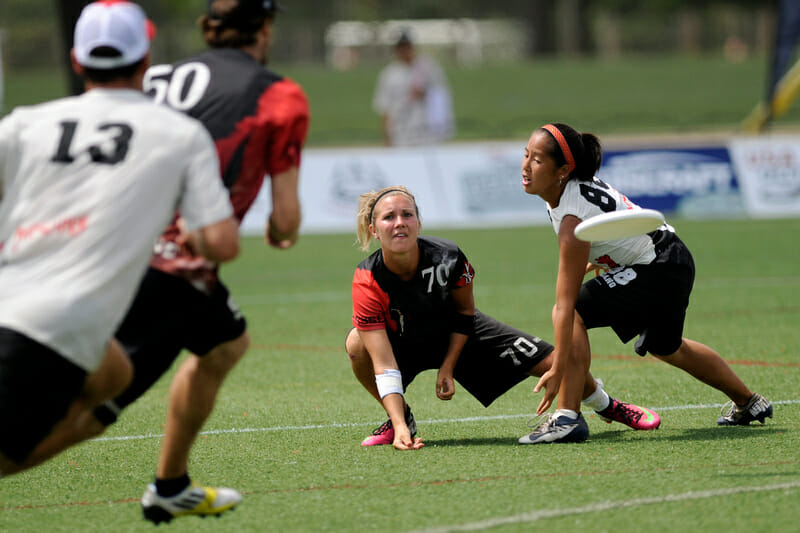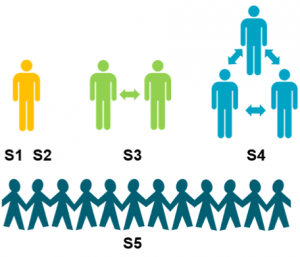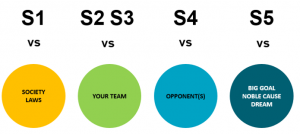How does the theory of Tribal Leadership relate to ultimate?
November 28, 2017 by Guest Author in Opinion with 0 comments

This article is presented by Spin Ultimate; all opinions are those of the author. Please support the brands that make Ultiworld possible and shop at Spin Ultimate!
This article was written by Montreal-based guest author Guylaine Girard, former head coach of the AUDL’s Montreal Royal.
Some teams win one championship and then quickly return to the shadows. Other teams win titles year after year. They stay at the top. These teams are known for their excellence —they continue to win, even as players come and go.
Why? What distinguishes teams with a long-term winning record from those that only experience fleeting success?
A few years ago, I discovered the theory of Tribal Leadership that provided elements to respond to these questions.
Tribal Leadership
In the book Tribal Leadership – Leveraging Natural Groups to Build a Thriving Organization, Dave Logan, John King and Halee Fischer-Wright explain that every organization is a tribe, made up of 20 to 150 individuals, who evolve together in a culture that is at a certain stage of development. According to the authors, there are five development stages, and Stage Five is the highest-performing.
How did the authors come to this conclusion?
As part of a presentation, author John King reveals a phenomenon he observed over the course of his career as a management consultant: 70 % of all business strategies fail. He was shocked. After more closely analyzing this problem, he and his co-authors determined that it was happening for one specific reason: the success of a company depends on a thriving corporate culture.
Following this discovery, Logan et al. developed specific tools to promote corporate success. This is how the theory of Tribal Leadership and the five stages of group development was born.
The Five Stages
Certain can people seem more productive and hard-working than others. You can say the same thing about groups. Each ultimate team has its own culture, which is more or less effective and efficient.
The authors of Tribal Leadership use a language approach to describe how an individual would express him/herself during each of the five tribal stages:
Stage One – « Life sucks »
Stage Two – « My life sucks »
Stage Three – « I am great »
Stage Four – « We are great »
Stage Five – « Life is great »
Each team is made up of individuals at one of these five stages. A team’s stage is determined by the stage at which the majority of its players can be found.
Stage One – Life Sucks
If you are at Stage One, you believe that you need to show violence and hatred to achieve success. A team at Stage One is not functional because the environment is too hostile. Rule following is not valued, and team members usually end up arguing or fighting amongst themselves. Think about a huddle where everyone is shouting over each other.
Stage Two – My Life Sucks
At Stage Two, life doesn’t suck for everyone, just for you. Apathy is the principal characteristic of this stage. You avoid all responsibility. It is always someone else’s fault; you are the victim.
A team at Stage Two has little success because it shows little or no initiative. Its members are resigned to their fate and do not look for ways to be more involved. Ever been losing 10-9 in a game to 12 and given up?
Stage Three – I Am Great
Stage Three is likely the most common stage for sports teams. An individual at Stage Three says, “I am great and you aren’t!”
Players are Stage Three are lone warriors. You do what it takes to get recognized within your group; you want to be the best. Think about trying to take over a point on offense.
A team in Stage Three is ready to do the work necessary to achieve its objectives but is not very productive because there isn’t enough cooperation between teammates. It is possible that there is plenty of talent within the group, but because people put themselves first, it is hard to achieve a coherent result. Think about a player who looks off an open in cut to instead throw to a contested huck.
Stage Four – We Are Great
Stage Four is the goal to which every team should aspire. At this stage, common values and a common adversary unite the members. The team’s success is more highly valued than individual success, members collaborate.
Teams experiencing Stage Four say, “We are great and our opponents aren’t!”
A team at Stage Four is productive and successful because its members are committed to the team. The ability to use each member’s ideas and strengths creates opportunities for innovation and success. Members who act selfishly are quickly brought into line, or they will simply not be allowed on the team.
Stage Five – Life Is Great
While Stage Four is optimal for a group, Stage Five is where the magic happens.
At Stage Five, the group’s cause is more important than anything else, and personal gain does not exist. Members can feel an almost religious fervor for their ultimate goal.
While the culture at Stage Five is inspirational and high-achieving, it is often built around a huge discovery or realization, which makes it potentially unstable. The euphoria members feel about their goal cannot last.
Leading a team towards a higher stage
If you are a leader, it is your responsibility to lead your team to a higher stage to ensure long-term success. To build a growing and sustainable program, we must put effort into meeting with our players to get them involved, to establish roles and to define a team framework. Often, we are looking for immediate results and we focus on improving on-field skills while competitiveness between players undermines their relationship, but that can slow the process of moving on to a higher stage, or bring the team back down.
Here are some examples of leaders I know who have guided their team to a higher stage of development.

In each stage, one must also consider the adversary. Here’s my look at what you or your team is up against as you progress through stages.

Though the examples above are discrete in theory, ultimate players and teams can move through them at different rates and for different reasons. Here are just a couple that illustrate what Logan et al researched and explained in their book.
From Stage One To Stage Two, And Beyond
Taking people out of a hostile environment to invite them into a new group allows them to connect with others and grow from one stage to another. That’s what Gustavo Castaño – former captain of Team Columbia in 2008, and player of AUDL Montreal Royal in 2015 – did while he was living in Medellín, Columbia.
In 2003, Castaño and Mauricio Moore, coach of Team Colombia at the 2017 World Games, initiated a project to teach ulltimate in a school with a disadvantaged population. To recruit the players, they offered participants a muffin and a bag of soy milk, snacks sponsored by the government that funded the project. The players had to first participate in the activity to receive their snack.
As soon as a conflict arose within the group, the players responded naturally with fists. “I had to stop the activity very often to teach young people the values of sport and the sportsmanship behaviors to adopt,” said Castaño. Over time, the players learned to communicate.
Some young people who were not from this school came to register for the activity. A rule was introduced: young people had to be enrolled in a school to participate. Kids started to enroll in a school because they wanted to play ultimate.
A year later, the project was running in 12 schools. One of its great successes was the formation of an elite group which, in 2005, joined the program called Escuelas Populares del Deporte. Six excellent Revolution players, four women and two men, came from this program. Revolution and many other programs have benefitted from this projects growth from Stage One to Stage Two and beyond.
From Stage Three To Stage Four
Montreal Odyssée, 2013 US Open Mixed Division Champions, walked the path towards Stage Four. Odyssée had a dream: being the first mixed team from Quebec to qualify for WUGC in 2012. The captains led the team by sharing values of teamwork, discipline, accountability, and equality between players. They wanted to inspire their teammates and surpass previous seasons.
They did not reach their goal of winning Canadian Nationals in 2011 to qualify for Worlds, losing by two points in finals against TFP. Despite the heartbreaking loss, the team stayed together for two more years. Odyssée organized many events and tournaments that strengthened the ties between players and brought together the ultimate community. Their work hit a climactic peak when they won the U.S. Open, and also when they placed seventh at Nationals in 2013, the best finish at US Club Championships for a team from Quebec. They achieved Stage Four.
Identify Your Team’s Stage
You can identify your team’s stage based on the following four characteristics:
- The way in which players interact
- The nature of the adversary
- The level of accountability among the players
- The level of player empowerment and closeness to the leader
What stage is your team at? And where are you headed?